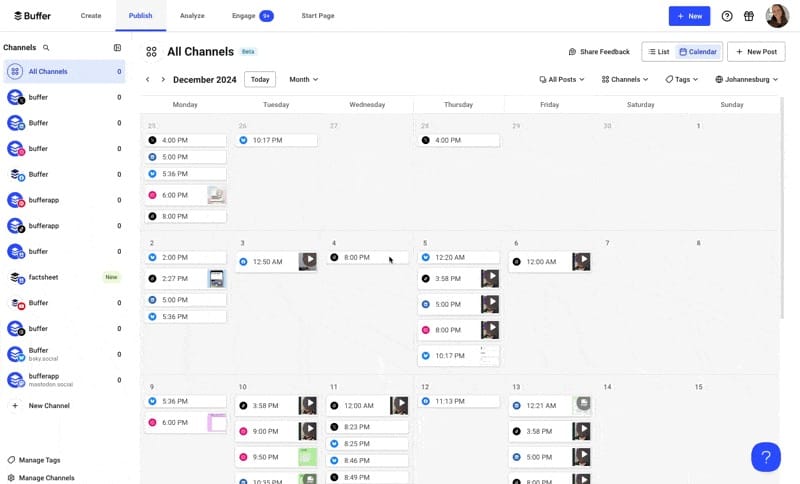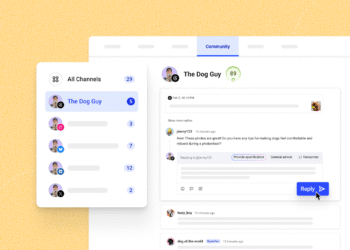You don’t need statistics to tell you that most brands and creators build their presence on more than one social media platform.
A quick look at a business’s website will give you multiple options to follow them on different social networks. And creators often add their audience numbers from different platforms in their social bios so you can find and follow them on other networks too.
They’re posting videos, sharing photos, and writing text posts across two (or more) platforms — but it doesn’t mean spending all day creating unique content for each channel.
In fact, many successful creators and brands have a secret: they crosspost across platforms to get more mileage out of their content.
What is crossposting?
Crossposting is when you share the same (or similar) content on multiple social media accounts.
For example, musician Ren shares his videos on Instagram Reels, as seen here:
And he posts the same videos on TikTok:
@renmakesmusic a cover of a classic ❤️ #renmakesmusic #sting #messageinabottle #uksinger #livesession #ukartist
It’s the same content, and he gets a ton of engagement on both platforms.
If this seems like double the work, it’s actually the opposite: You can create posts once and share them everywhere your audience hangs out.
Whether you use a platform’s built-in features (like crossposting between Facebook, Instagram, and Threads) or a social media management tool like Buffer, it’s a streamlined process that lets you crosspost in just a few clicks.
Why crosspost on social media?
Crossposting is a game-changer for busy creators and small businesses that want to maintain an active presence across multiple channels. Here’s why it works so well.
Build a stronger social media presence
Being present on multiple social media channels is becoming increasingly important for creators and businesses. Platforms can change, so it protects you from putting all your eggs in one basket. And it gives your content more opportunities to take off.
While you don’t need to be everywhere, maintaining two or three platforms can help you build a more resilient online presence. Crossposting makes this multi-platform strategy more manageable.
Save time
For busy creators and small businesses managing multiple pages, crossposting is a smart way to maintain a consistent posting cadence across social platforms in less time.
By crossposting strategically, you can focus your energy on creating high-quality content that resonates with your followers without burning out.
For example, if you create an enticing teaser video for an upcoming product launch, you can post it across Instagram Reels, TikTok, and YouTube Shorts. Just adjust the captions and hashtags for each platform, and you’re good to go.
Reach more of your audience
Your followers likely use multiple social platforms but might not follow you on all of them. By crossposting your content, you increase the chances that your message reaches your audience where they’re most active.
Even if someone follows you on multiple platforms, they might miss your post on X but catch it on Threads.
And since each platform has its own unique user base, crossposting helps you connect with different audiences who might be interested in your content.
For example, your Facebook Page might attract different followers than your Instagram account. By posting on both, you can grow your overall social media fan base and get more views and engagement.
Test new platforms efficiently
Crossposting also helps you test a new social media channel without doubling your content creation time. For instance, if you’re curious about building an audience on text-based platforms, you can try crossposting your content across X, Threads, Bluesky, and Mastodon to see where it resonates most.
If short-form video is your focus, you can test how your content performs across TikTok, Instagram Reels, and YouTube Shorts.
This approach lets you experiment with different platforms while maintaining a consistent content strategy. You can analyze engagement across platforms and focus your efforts where they’ll have the biggest impact.
How to crosspost effectively on social media
Ready to make crossposting work for your social media strategy? Keep these key principles in mind to make an impact.
Start by crossposting to platforms that use similar media
The easiest way to start crossposting is to focus on platforms that share similar content types:
- Text-based platforms: X, Threads, Bluesky, Mastodon
- Video-focused platforms: TikTok, Instagram Reels, YouTube Shorts
- Image-focused platforms: Instagram feed, Pinterest
For example, you can easily adapt a recipe post from your Instagram feed for Pinterest.
You can also crosspost to platforms with different media-focuses (e.g., an Instagram image to X), but you’ll likely need to customize your content a bit more since posts are presented differently on these platforms.
For example, Shopify posted this photo to Instagram:
And then again on X:
iphone: your storage is full
me: how can it be full already?my camera roll: pic.twitter.com/gg73s0lOJ5
— Shopify (@Shopify) December 4, 2024
Each post has a slightly different caption to suit the platform. Because X shows text first, followed by the image, having a strong text lead-in makes sense.
Meanwhile, Instagram’s caption appears after the photo in followers’ feeds and gets cut off after the first couple of lines, prompting followers to click it if they want to read the whole thing. So a shorter caption makes sense there.
When you’re sharing content to platforms with different focuses, you’ll probably want to learn more about repurposing content — another smart strategy to get more out of your content that involves a bit more finesse.
Only crosspost content that fits your audience on each platform
Every social platform has its own culture and audience expectations. Whatever you share, you’ll want to stay consistent with the style your audience expects from each one.
For example, TikTok tends to be more spontaneous and off-the-cuff than Instagram Reels. So something more refined might not land on TikTok.
In my own experience, I tried crossposting from X, where I was building an audience of e-commerce marketers, to LinkedIn, where I had more connections in the content marketing world. While my LinkedIn posts about content marketing and work culture usually get decent engagement, the e-commerce posts fell flat! It wasn’t the right topic for the audience I had built.
Customize your content for each platform
Because every platform has its own norms and technical requirements, you’ll likely want to make some small tweaks before reusing your content.
Here’s what to consider adjusting before you crosspost:
Character limits: Each platform has its own character limits. For example, LinkedIn has a 3,000-character limit, while X is limited to 280 for free users. If you have a long LinkedIn post, you might consider splitting it up into a thread for X. Or you can just post part of it to the platform.
Image sizes and video lengths: Make sure your images and videos meet each platform’s recommended dimensions and durations. An Instagram Reel can be up to 90 seconds long, while TikToks can be up to 30 minutes (depending on your region). If you want to share to both of those platforms with minimal extra effort, keep your clips to 90 seconds or less.
Tools like CapCut can help you create short clips from a longer video to suit different platform requirements — though this edges more into content repurposing than straight crossposting.
Hashtags: Different platforms have not only different hashtags to use, but audiences have different expectations about their use. Hashtag use is heavy on Instagram, and you can expect to see dozens of hashtags in a single post to boost discovery. LinkedIn users, on the other hand, tend to use just one or two relevant tags.
Platform tone: Each platform has its own communication style. LinkedIn tends to be more professional and industry-focused, so you might want to lighten up on your slang there. But you can loosen up more on TikTok, which favors a more casual feel.
Seeing ‘link in bio’ on a Facebook page immediately signals that content was copied without customizing. Make sure you remove or update platform-specific mentions, so each post fits the platform you’re sharing it on.
Optimal posting times: Your audience’s active hours might vary by platform. Schedule your crossposted content when your followers are most likely to engage on each specific platform. Buffer’s analytics can help you figure out the best time to post for your audience.
💡
Use Meta’s built-in crossposting features
If you’re posting content across your Instagram, Threads, and Facebook accounts, you can take advantage of Meta’s native crossposting features.
This built-in functionality lets you easily share content between your Facebook page, Instagram account, and Threads profile — as long as the post type is supported on the other platforms.
This only works within Meta’s social networks, and it’s especially useful for spontaneous content when you want to quickly share across platforms.
Crosspost like a pro with a social media management tool
Crossposting manually can be tedious and time-consuming. We recommend using a social media management platform like Buffer that makes crossposting a breeze.

With Buffer, you can:
- Draft and schedule posts to multiple channels at once
- Customize content for each platform as you schedule
- Use the AI Assistant to adapt your content for different platforms
- Duplicate posts you’ve already drafted or published
- Schedule posts at the right time for each platform
Ready to get more out of your content with crossposting? You can get started with Buffer for free to share your content more efficiently across platforms.
Crossposting FAQs
Is it OK to share the exact same post on every platform?
You can, but a small tweak goes a long way. Platforms differ in tone, image size recommendations, and character limits. Adjusting your captions, hashtags, or video length helps each post feel at home on that specific platform and keeps your followers engaged everywhere.
What is crossposting on Instagram?
It’s the one-tap way to share an Instagram post or reel to another linked platform, usually Facebook. After you connect your Instagram professional account to a Facebook Page, you just switch on “Share to Facebook” before you publish on Instagram. Your post then shows up natively in both feeds with no extra upload time.
You can do the same with Threads if your profile is connected to your Instagram account.
You can also crosspost from Instagram to Facebook, Threads, and other social media platforms using a social media management tool like Buffer.
How do I crosspost from Instagram to Facebook?
Follow these steps to crosspost from Instagram to Facebook:
- On Instagram, open Menu › Crossposting › Accounts Center and link your Facebook Page.
- Start a post or reel, then toggle on Also share on Facebook before you tap Share.
- Your content publishes to both feeds at once.
Pro tip: Using Buffer, you can write one post, tweak each caption, and schedule it to Instagram and Facebook in a single workflow.
What does “crossposted” mean on Facebook videos?
Crossposted tells you the same video file was published on several Facebook Pages that have a crossposting relationship. Each Page shows the clip as a native post, yet all views count toward one total. Comments and reactions stay on the Facebook Page where people leave them.
What’s a quick example of crossposting?
When you shoot one 60-second product demo, upload it as an Instagram Reel, then share the same clip to TikTok and YouTube Shorts. Keep the video the same, tweak the caption and hashtags, and you’ve reached three audiences with one piece of content.
You can use a social media management tool like Buffer to crosspost content to your audience across different platforms.


















